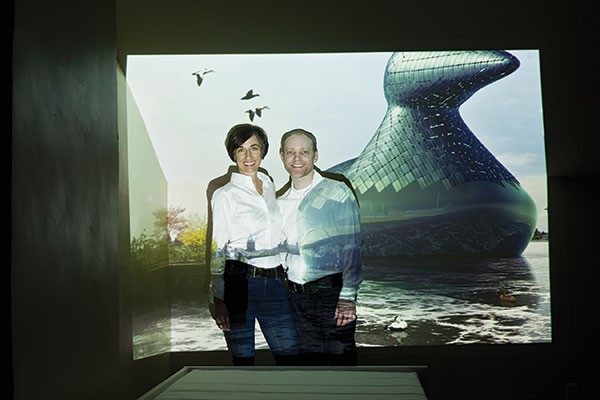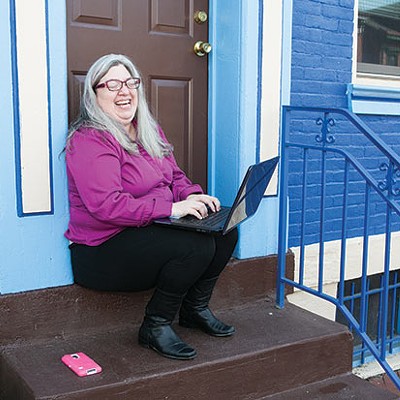
The Land Art Generator Initiative is a Pittsburgh-based organization with a proposal for a conspicuous local project. "Wind Nest" (designed by Philadelphia-based firm SUPRAFUTURES at LAGI's direction) is a clean energy-producing structure combining wind turbines and thin-film solar cells and intended for a spot in Schenley Plaza. Yet the organization and its work are truly global in scope, vision and reputation.
The organization effectively started in the United Arab Emirates. Artist Elizabeth Monoian and architect Robert Ferry, both of whom earned degrees at Carnegie Mellon University about 15 years ago and got married shortly thereafter, moved to Dubai in 2008. They were immediately inspired by the remarkable desert landscape and its possibilities for environmentally considered experiments in art and architecture.
"We found that there is a strong history of Emirati artists working in land art," Monoian recalls, making comparisons to artists such as Robert Smithson and Maya Lin. They also saw in some avant-garde high-rise architecture of the Middle East "what one could even call sustainable expressionism," says Ferry, where renewable-energy systems such as windmills and solar panels "start to define the expression of the building's exterior."
Taking those influences one step further, they began to imagine public-art projects that would generate and export clean electricity to the power grid. It was crucial to conceive these as art, because often people don't want to see sustainable energy infrastructure. "People will say, ‘Don't use a turbine in a place we want to look at,'" explains Ferry. LAGI (pronounced "loggy") set out to change the aesthetics and the attitude.
With essentially no money at their disposal, Ferry and Monoian organized a design competition in which they asked architects, landscape architects, engineers and other designers to form teams and propose projects of the kind they wanted to see. "The starting brief was quite simple," says Monoian. "We asked that the artwork capture energy from nature and cleanly convert it to electricity. We asked that teams consider the safety of the viewing public. And we asked that designs be constructible rather than theoretical. Our goal from day one has been to build them." To their surprise, their first competition, for the three UAE sites, drew 120 entries from around the world. Outputs of electricity on the projects range from a modest 7.5 megawatt-hours per year to 2,000 mwh per year, enough to power some 200 homes.
Because even the most level-headed proposals can require years of research and development, the first LAGI project has not yet been built. That is why the "Wind Nest" proposal is so tantalizing: Of all the projects, it would be the easiest to realize technically. (Also, LAGI is now based in Lawrenceville.) However, "Wind Nest" has reached an apparent impasse in the city's Public Art Commission. (See "Out of Site,")
Meanwhile, LAGI's competitions have become international biannual enterprises that have have elicited greater participation, sponsorship and enthusiasm. The 2012 competition targeted Fresh Kills, in New York City, a landfill reclaimed as a park. The U.S. Department of Energy signed on as a juror. Sponsors include Masdar City, a government-funded sustainable city in Abu Dhabi. "They very much fell in love with the project," says Ferry. Now, too, there is prize money, with $15,000 going to the jury-selected winner. For the Fresh Kills site, that project was "Scene Sensor," a translucent, box-like pedestrian bridge and viewing station with thousands of hinged flaps as piezo-electric generators (tiny generators able to convert very small mechanical movements into electricity).
Though actual construction plans are slow to develop for some of the sites, outreach efforts continue. German publisher Prestel, known for its elegant and selective subjects in architecture and art, now produces a hard-backed catalogue with essays for each of the LAGI competitions; Regenerative Infrastructures, for the 2012 Fresh Kills competition, and New Energies, for 2014 in Copenhagen, are the two titles thus far. LAGI also provides three additional publications as free downloadable pdfs on its website. In the U.S., a number of schools of architecture and landscape architecture, at universities including Yale, the University of Pennsylvania and RPI, use LAGI competitions as assigned problems for their students. That has turned the competitions into a de facto university-level educational standard.
And that built project will come. The 2016 competition is for a site in Los Angeles. Green Build, the annual conference of the U.S. Green Building Council, takes place that year. Monoian and Ferry say that the USGBC wants to build a demonstrator project, similar to "Wind Nest," in Los Angeles in time for the convention. They will be realizing either what has already happened in Pittsburgh, or what Pittsburgh had a chance to do first but passed up.


















